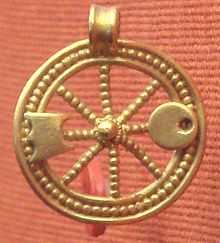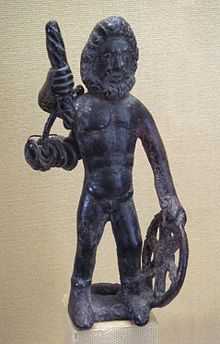Arduinna
- "Arduina" redirects here. For the asteroid, see 394 Arduina. For the plant genus, see Carissa.
In Celtic mythology, Arduinna (also Arduina, Arduinnae or Arduinne) was the eponymous goddess of the Ardennes Forest and region, represented as a huntress riding a boar (primarily in the present-day regions of Belgium and Luxembourg). Her cult originated in what is today known as Ardennes, a region of Belgium, Luxembourg and France. She was later assimilated into the Gallo-Roman mythology of goddess Diana.[1]
Depictions
In The Gods of the Celts, Miranda Green states that some depictions of Arduinna show her riding a boar[2] However, Simone Deyts[3] notes that the bronze Gallo-Roman statue of a woman in a short belted tunic, riding a boar sidesaddle and holding a knife, conserved in the Musee des Antiquites Nationales, St-Germain-en-Laye,[4] bears no inscription, and was simply assumed to be Arduinna by the 19th century antiquarian who discovered it— perhaps because the modern symbol of the Ardennes region is also a boar .[5]
Inscriptions
Arduinna is known from two inscriptions:
- Düren, Germany deae Ardbinnae (CIL XIII, 07848)
- Rome, Italy Arduinne (CIL VI, 00046)
Etymology
The name Arduinna derives from the Gaulish arduo- meaning height.[6] It is also found in several placenames, such as the Ardennes Woods (Arduenna silva), the Forest of Arden in England, in personal names Arduunus and Arda — the latter from coinage of the Treveri, (RIG-4, 36-43) — and the Galatian Αρδή. The name Arduenna silva for "wooded heights" was applied to several forested mountains, not just the modern Ardennes: it is found in the départements of Haute-Loire and Puy-de-Dôme and in the French commune of Alleuze.[7]
It has also been suggested that the gemination -nn- is typical to a language of the Belgae,[8] being different from Celtic and thus suggesting a Nordwestblock etymology, which, generally speaking, is also assumed to be closer to Germanic.
Historical references
In 565, St. Walfroy (Wulfilaïc) preached to the local population of Villers-devant-Orval to persuade them to abandon worship of Arduinna.
References
- ↑ Some of Diana's attributes have then been reflected to Arduina: "In Celtic mythology Arduina is the goddess of woodlands, wild life, the hunt and the moon." (Ramesh Chopra, ed. (2005) Academic Dictionary Of Mythology, s.v. "Arduina").
- ↑ Green, Gods of the Celts, 1986, p. 180; the connection is also made in popularized guidebooks such as B.G. Walker (1991), Woman's Dictionary of Symbol and Sacred Objects (San Francisco: Harper) and J.C. Cooper (1992) Symbolic and Mythological Animals (London).
- ↑ Deyts, Simone (1992) Images des Dieux de la Gaule (Images of the Gods of Gaul). Paris: Editions Errance. ISBN 2-87772-067-5
- ↑ The bronze is illustrated in Boucher, S. (1976) Recherches sur les Bronzes Figurés de Gaule Pré-romaine et Romaine (Research on the Bronze Figures of Gaul, Pre-Roman and Roman). Paris, Ecole Français de Rome, fig.292, or Bridgeman archives: Arduinna) another such bronze from the collection of Richard Payne Knight, has been in the British Museum since 1824; it is traditionally identified as "Diana": illus.
- ↑ Deyts 1992, pp. 46–47.
- ↑ Delamarre, Xavier and Lambert, P.Y. (2003). Dictionaire de la Langue Gauloise (Dictionary of the Gaulish Language). 2nd edition. Paris, Editions Errance. ISBN 2-87772-237-6, p. 51).
- ↑ Delamarre pp. 51–52.
- ↑ e.g. M.Gysseling, De Vroegste geschiedenis van het Nederlands: een taalkundige benadering in Naamkunde 2, 1970, p157-180
- Colbert de Beaulieu, Jean-Baptiste and Fischer, Brigitte (1998) Receuil des Inscriptions gauloises (RIG) 4: les légendes monétaires. Paris, Editions du CNRS
- Corpus Inscriptionum Latinarum (CIL), volume 6, Italia
- Corpus Inscriptionum Latinarum (CIL), volume 13, Tres Galliae
- Green, Miranda (1986) The Gods of the Celts. Stroud, Sutton Publishing. ISBN 0-7509-1581-1

